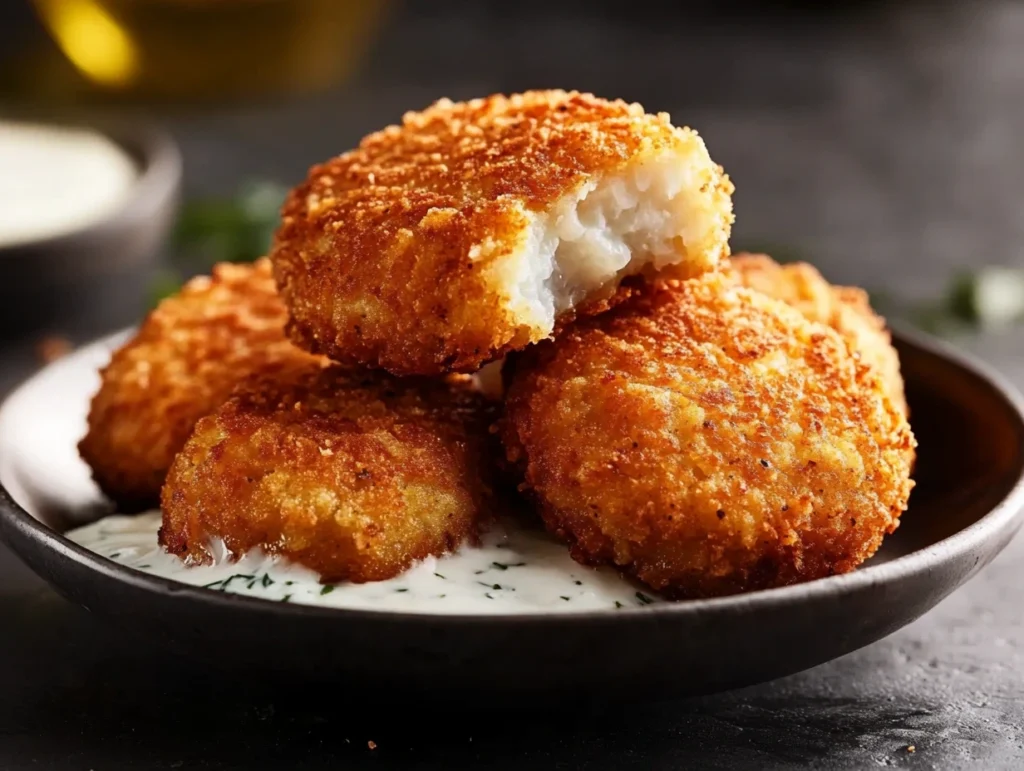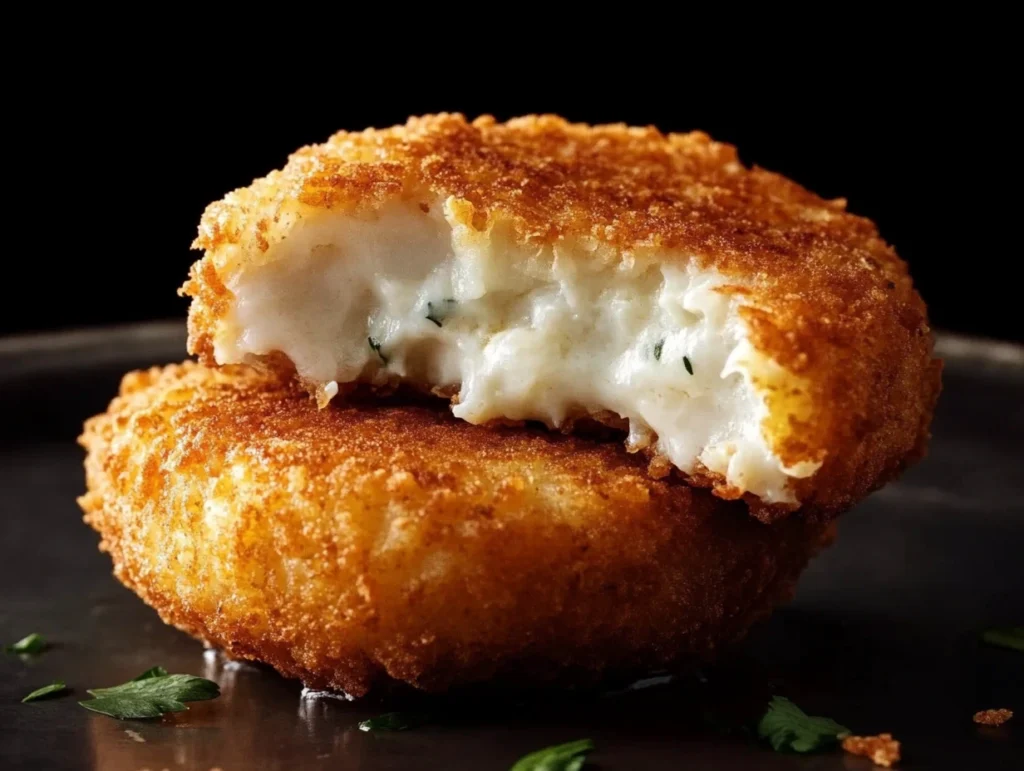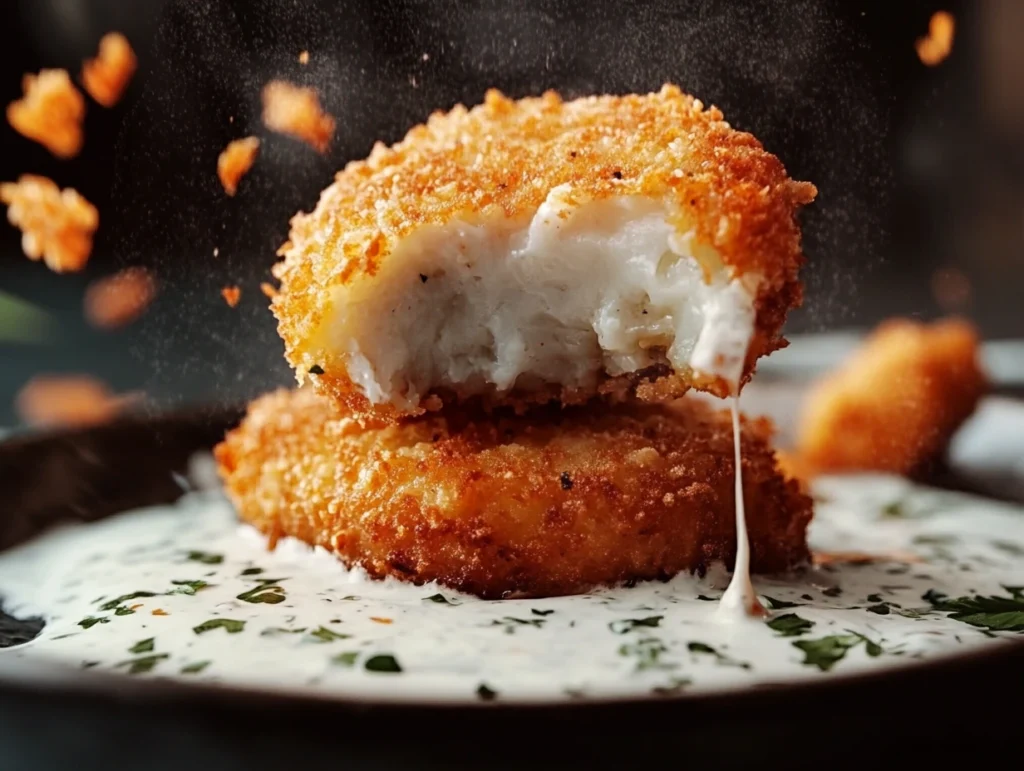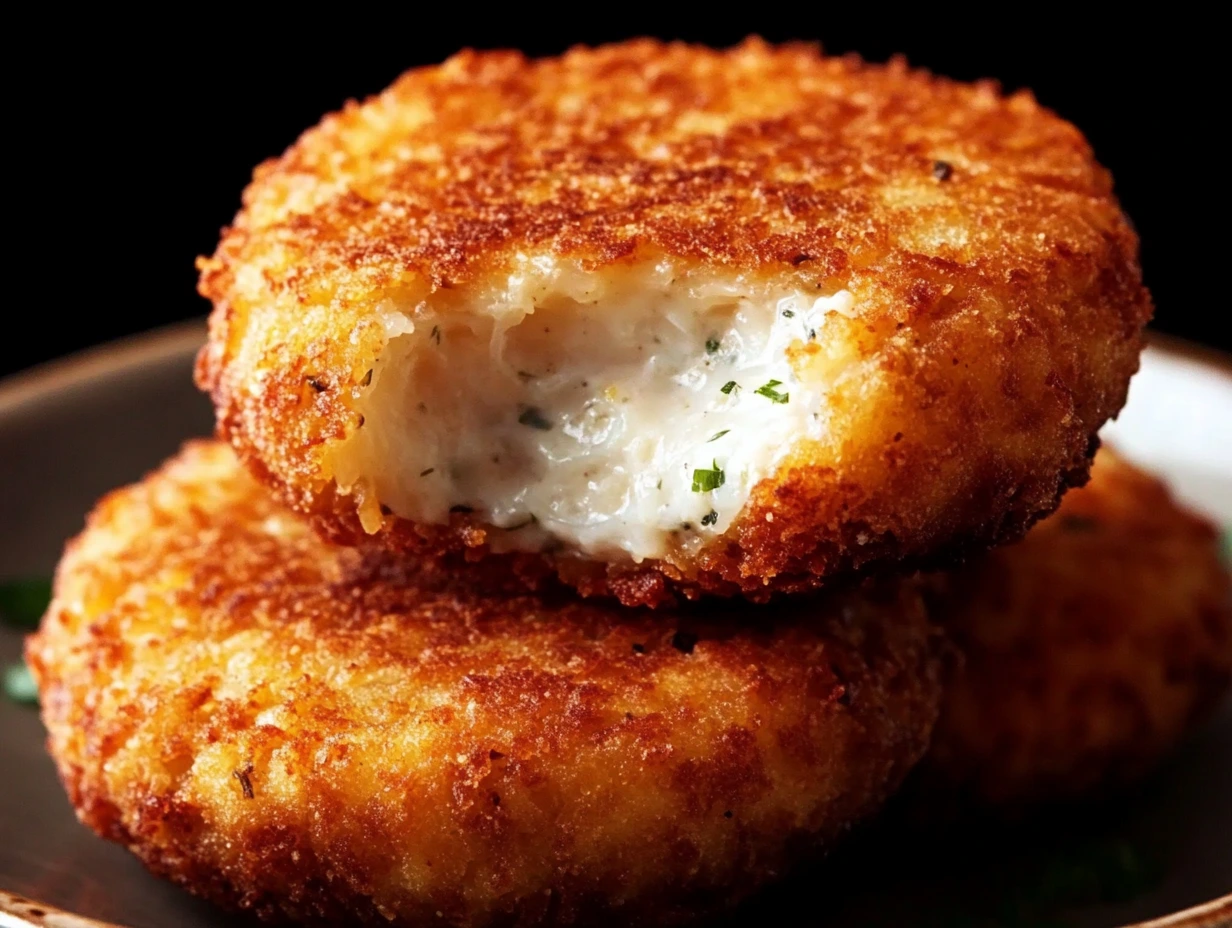Introduction to Fish Cakes
Fish cakes recipe are a delightful culinary creation, combining the fresh, savory taste of fish with a perfect blend of seasonings and fillers. Originating in various cuisines across the world, fish cakes are a versatile dish that can be served as a main course, appetizer, or snack. Their crispy exterior and tender, flavorful interior make them a favorite for all ages.

Table of Contents
Why Make Fish Cakes at Home?
Making fish cakes at home allows you to customize them to suit your preferences, from the type of fish used to the seasoning and add-ons. Store-bought versions often contain preservatives and additives, but homemade fish cakes are fresher, healthier, and can be tailored to dietary needs. Additionally, they are a great way to use up leftover fish, reducing food waste while creating something delicious.
Ingredients
Primary Ingredients
- Fish – 2 cups of cooked and flaked fish (e.g., cod, salmon, tuna, or haddock)
- Potatoes – 2 medium-sized potatoes, boiled and mashed
- Onion – 1 small onion, finely chopped
- Egg – 1 large egg, lightly beaten
- Breadcrumbs – 1 cup, for binding and coating
- Salt and Pepper – To taste
- Parsley – 2 tablespoons, chopped (optional for flavor)
- Oil – For frying
Optional Add-ons
- Spices – Paprika, chili flakes, or garlic powder for added flavor
- Lemon Zest – For a tangy kick
- Cheese – Grated cheddar or parmesan for a creamy texture
- Vegetables – Finely chopped carrots, peas, or corn for added nutrition
- Herbs – Dill or cilantro for a different twist
Essential Equipment
Kitchen Tools Needed
- Mixing Bowl – To combine all the ingredients.
- Cutting Board – For chopping onions, herbs, and other add-ons.
- Knife – A sharp knife for precision cutting.
- Potato Masher – For mashing the boiled potatoes.
- Frying Pan – A non-stick pan for frying the fish cakes.
- Spatula – For flipping the fish cakes without breaking them.
- Measuring Cups and Spoons – For accurate measurements.
Alternative Tools
- Fork – Can be used in place of a potato masher for mashing potatoes.
- Food Processor – For finely chopping ingredients or creating a smoother mixture.
- Baking Sheet – If you prefer baking the fish cakes instead of frying.
- Air Fryer – A healthier option for cooking without much oil.
Step-by-Step Preparation
Prepping the Fish
- Cook the Fish – If using fresh fish, cook it by steaming, boiling, or baking until tender. Let it cool, then flake it into small pieces using a fork.
- Check for Bones – Carefully remove any small bones to ensure the mixture is smooth and safe to eat.
Preparing the Mixture
- Mash the Potatoes – Boil the potatoes until soft, then mash them until smooth and lump-free.
- Combine Ingredients – In a mixing bowl, combine the flaked fish, mashed potatoes, chopped onion, parsley (if using), salt, and pepper. Mix well to form a cohesive mixture.
- Add Egg – Add the beaten egg to bind the mixture together. If it’s too wet, sprinkle in some breadcrumbs.
Shaping the Cakes
- Divide the Mixture – Scoop out equal portions of the mixture using a spoon or your hands.
- Shape the Cakes – Form each portion into a round patty or your desired shape.
- Coat with Breadcrumbs – Roll each cake in breadcrumbs, ensuring an even coating for a crispy texture.

Cooking Methods
Pan-Frying
- Heat the Oil – Add a thin layer of oil to a frying pan and heat over medium flame.
- Cook the Cakes – Place the fish cakes in the pan, ensuring they don’t overcrowd. Fry for 3-4 minutes on each side or until golden brown and crispy.
- Drain Excess Oil – Remove the fish cakes and place them on a paper towel to absorb excess oil.
Baking
- Preheat the Oven – Set the oven to 375°F (190°C).
- Prepare the Tray – Line a baking sheet with parchment paper or lightly grease it.
- Bake the Fish Cakes – Place the cakes on the tray, leaving space between them. Bake for 20-25 minutes, flipping halfway, until golden and firm.
Air-Frying
- Preheat the Air Fryer – Set the air fryer to 375°F (190°C) for 3-5 minutes.
- Arrange the Cakes – Place the fish cakes in the basket, ensuring they’re not touching for even cooking.
- Cook the Cakes – Air fry for 12-15 minutes, flipping halfway through, until crispy and golden.
Serving Suggestions
Best Pairings
- Dipping Sauces – Serve with tartar sauce, garlic aioli, spicy mayo, or a tangy yogurt-based dip.
- Salads – Pair with a fresh green salad, coleslaw, or a citrusy avocado salad for a lighter meal.
- Sides – Serve alongside roasted vegetables, mashed potatoes, or steamed rice for a complete dish.
Garnishing Tips
- Fresh Herbs – Sprinkle chopped parsley, dill, or cilantro over the fish cakes for a burst of freshness.
- Lemon Wedges – Add lemon wedges to the plate for an optional zesty squeeze.
- Microgreens – Top with microgreens for an elegant touch and extra nutrients.
Common Mistakes
Overcoming Common Issues
- Dry Fish Cakes – If the mixture is too dry, add a little milk, cream, or extra mashed potatoes for moisture.
- Cakes Falling Apart – Ensure the mixture is well-combined, and use enough egg as a binding agent. If the issue persists, add more breadcrumbs.
- Uneven Cooking – Cook over medium heat to ensure the fish cakes cook through without burning on the outside.
Tips for First-Timers
- Test the Seasoning – Cook a small portion of the mixture and taste it to adjust seasoning before shaping all the cakes.
- Chill the Mixture – Refrigerate the mixture for 30 minutes before shaping to make it easier to handle.
- Don’t Overcrowd the Pan – Cook in batches to ensure even browning and prevent steaming.
Variations
Gluten-Free Fish Cakes
- Use Gluten-Free Breadcrumbs – Replace regular breadcrumbs with gluten-free options or crushed rice crackers.
- Alternative Bindings – Use mashed sweet potatoes or cooked quinoa for a gluten-free alternative.
Vegan Substitutes
- Replace Fish – Use mashed chickpeas, jackfruit, or firm tofu to mimic the texture of fish.
- Egg Alternatives – Use flaxseed or chia seed mixed with water (1 tbsp seed + 2.5 tbsp water = 1 egg) as a binder.
- Dairy-Free Option – Opt for plant-based milk if needed for moisture.

Storing and Reheating
Best Practices for Storage
- Refrigeration – Store cooked fish cakes in an airtight container in the fridge for up to 3 days.
- Freezing – Arrange uncooked or cooked fish cakes in a single layer on a baking sheet, freeze until solid, and then transfer to a freezer bag for up to 2 months.
How to Reheat Without Losing Flavor
- Oven – Preheat to 375°F (190°C). Place fish cakes on a baking sheet and heat for 10-15 minutes.
- Stovetop – Reheat in a lightly oiled pan over medium heat for 3-4 minutes on each side.
- Air Fryer – Heat at 350°F (175°C) for 5-7 minutes for a crispy texture.
Nutritional Information
Calorie Breakdown
The exact nutritional values may vary depending on the ingredients and portion sizes. Below is an approximate breakdown for one standard fish cake (made with cod, potatoes, and breadcrumbs, pan-fried):
- Calories: 150-200 kcal
- Protein: 12-15 g
- Carbohydrates: 12-15 g
- Fats: 6-10 g
- Fiber: 1-2 g
- Sodium: 200-300 mg
Using alternative ingredients (e.g., air-frying instead of pan-frying or adding cheese) will adjust these values accordingly.
Health Benefits of Ingredients
- Fish
- Rich in Omega-3 Fatty Acids: Supports heart and brain health.
- High-Quality Protein: Essential for muscle repair and growth.
- Packed with Vitamins: Includes vitamin D and B12 for overall well-being.
- Potatoes
- Complex Carbohydrates: Provide sustained energy.
- Rich in Potassium: Helps regulate blood pressure.
- Breadcrumbs
- Adds a satisfying crunch and texture. Opt for whole-grain breadcrumbs for added fiber.
- Eggs
- High in protein and essential nutrients like choline, which supports brain health.
- Herbs (e.g., Parsley)
- Antioxidants and vitamins (A, C, and K) that support immunity and bone health.
- Optional Add-ons (e.g., Spices, Lemon Zest)
- Spices: Contain anti-inflammatory properties.
- Lemon Zest: Adds vitamin C and enhances flavor without extra calories.
Frequently Asked Questions (FAQs)
What kind of fish is best for fish cakes?
You can use almost any type of fish for fish cakes, but firm, flaky white fish like cod, haddock, or pollock works best. Salmon, tuna, or even a mix of seafood can also be used, depending on your preference. Fresh or cooked leftover fish are equally suitable.
Can I freeze fish cakes?
Yes, fish cakes freeze very well. For uncooked fish cakes, arrange them in a single layer on a baking sheet, freeze until solid, then transfer to an airtight freezer bag. For cooked fish cakes, cool them completely before freezing. Both can be stored for up to 2 months. Thaw in the refrigerator before reheating or cooking.
How do I prevent them from falling apart?
To prevent fish cakes from falling apart:
- Use an egg as a binding agent.
- Avoid overmixing the ingredients, but ensure they are well combined.
- Chill the mixture in the refrigerator for 30 minutes before shaping.
- Handle gently when shaping and cooking.
What are some vegan alternatives?
For vegan fish cakes:
- Replace fish with mashed chickpeas, jackfruit, or a combination of shredded vegetables like zucchini and carrots.
- Use flaxseed or chia seed mixed with water (1 tbsp seed + 2.5 tbsp water = 1 egg) as an egg substitute.
- Opt for plant-based breadcrumbs and non-dairy milk if needed.
Are fish cakes healthy?
Fish cakes can be a healthy choice when made with wholesome ingredients:
- Fish is an excellent source of protein and omega-3 fatty acids.
- Adding vegetables and herbs increases the fiber and nutrient content.
- Opt for baking or air-frying instead of pan-frying for a lower-fat option.
Can I use canned fish?
Yes, canned fish is a convenient and affordable option for fish cakes. Tuna, salmon, or mackerel work particularly well. Ensure the fish is drained thoroughly before mixing to prevent the cakes from being too wet.
When preparing your fish cakes, you might enjoy pairing them with crispy fried zucchini for a light, crunchy side dish. If you’re experimenting with alternative cooking methods, consider trying an air fryer recipe for red potatoes as a healthy and flavorful accompaniment. For those curious about other seafood options, check out this recipe for a rich and creamy seafood boil sauce to elevate your fish cakes into a gourmet meal.
Conclusion
Fish cakes are a delightful and versatile dish that can be customized to suit any palate. Whether you’re looking to make a quick and easy meal, impress guests with your culinary skills, or use up leftover ingredients creatively, fish cakes are a fantastic option. By following this guide, you’ll not only create delicious and healthy fish cakes but also explore new techniques and pairings to enhance your cooking experience.

